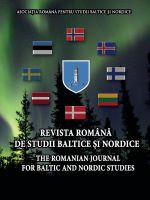The „hard” borders in the Baltic Sea Region, 1917-1922
The „hard” borders in the Baltic Sea Region, 1917-1922
Author(s): Silviu-Marian MiloiuSubject(s): History, Geography, Regional studies, Historical Geography, Diplomatic history, Local History / Microhistory, Military history, Political history, Modern Age, Pre-WW I & WW I (1900 -1919)
Published by: Asociatia Romana pentru Studii Baltice si Nordice
Keywords: Baltic Sea Region, 20th century; hard borders; hardening of borders; border and identities of exclusion; fetishization of territory;
Summary/Abstract: The British sociologist Gerard Delanty's conception of "boundary and identities of exclusion" in European history shall be remembered when approaching "hard borders." This concept takes into account the "cultural dynamics of self-identification through exclusion" and is germane when considering the interwar interactions between the countries of the Baltic area and Russia. The works of Reece Jones and Alec Murphy on "the hardening of borders" and "the fetishization of territory" as national traits are equally pertinent to the perception of frontiers during the duration of the 20th century, including the years 1917 to 1922. In every occasion in which war and violence (ultimatums, threats of force) were employed in the Baltic Sea Region to award borders in favor of one state or another or to settle accounts, the arrangements were not permanent and a cycle of warfare with terrible effects on local people followed. The combination of universalist ideologies (such as Communism) with imperial goals frequently resulted in both domestic and international conflicts. Civil unrest (sisällissota) and clashes with and between foreign troops (Russian and German) marked Finland's journey to independence. Comparable conditions existed in Estonia, Latvia, and Lithuania. In each case, the upshot was not just an obsession with boundaries, but also an increase in otherness and loss of life.
Journal: Revista Română de Studii Baltice şi Nordice
- Issue Year: 14/2022
- Issue No: 1
- Page Range: 7-48
- Page Count: 42
- Language: English

